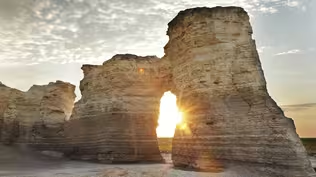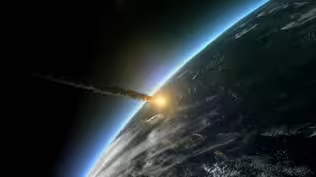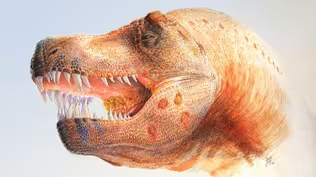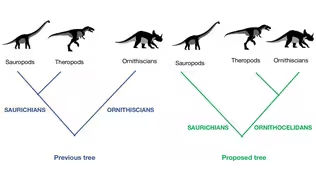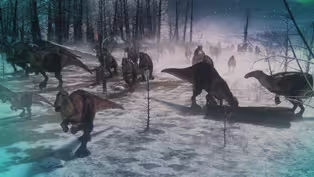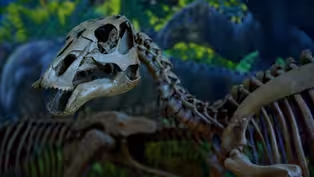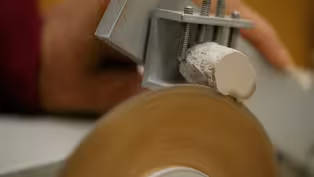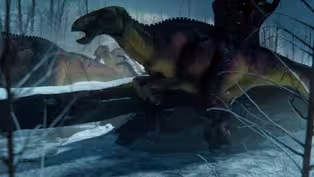
Alaskan Dinosaurs
Season 48 Episode 21 | 53m 21sVideo has Audio Description, Closed Captions
Intrepid paleontologists discover that dinosaurs thrived in the Arctic’s cold and dark.
A team of intrepid paleontologists discovers that dinosaurs thrived in the unlikeliest of places—the cold and dark of winter in the Arctic Circle. How did they survive year-round and raise their young in frigid and dark winter conditions?
See all videos with Audio DescriptionADProblems playing video? | Closed Captioning Feedback
Problems playing video? | Closed Captioning Feedback
National Corporate funding for NOVA is provided by Carlisle Companies and Viking Cruises. Major funding for NOVA is provided by the NOVA Science Trust, the Corporation for Public Broadcasting, and PBS viewers.

Alaskan Dinosaurs
Season 48 Episode 21 | 53m 21sVideo has Audio Description, Closed Captions
A team of intrepid paleontologists discovers that dinosaurs thrived in the unlikeliest of places—the cold and dark of winter in the Arctic Circle. How did they survive year-round and raise their young in frigid and dark winter conditions?
See all videos with Audio DescriptionADProblems playing video? | Closed Captioning Feedback
How to Watch NOVA
NOVA is available to stream on pbs.org and the free PBS App, available on iPhone, Apple TV, Android TV, Android smartphones, Amazon Fire TV, Amazon Fire Tablet, Roku, Samsung Smart TV, and Vizio.
Buy Now

NOVA Labs
NOVA Labs is a free digital platform that engages teens and lifelong learners in games and interactives that foster authentic scientific exploration. Participants take part in real-world investigations by visualizing, analyzing, and playing with the same data that scientists use.Providing Support for PBS.org
Learn Moreabout PBS online sponsorship♪ ♪ ♪ ♪ NARRATOR: The Arctic Circle, Northern Alaska.
In one of the most inhospitable places on Earth, scientists search for clues to a mystery 70 million years in the making.
They're on the hunt for a lost world of polar dinosaurs.
STEVE BRUSATTE: This is not the paleontology you normally see in books.
What we're learning about dinosaurs from these discoveries, it's just really unparalleled and unprecedented.
♪ ♪ NARRATOR: Alaska is the last place on Earth one might expect to find large reptiles.
But the discovery of fossils has revealed dinosaurs could live farther north than what was once thought possible.
(power tools running) Oh, we got a sweet layer right here.
(tools running) NARRATOR: Now this team hopes to answer some fundamental questions.
What kind of animals lived here?
How did they survive the Arctic winters?
BRUSATTE: How were they able to endure the cold?
How were they able to endure the darkness?
Where do they get their food?
GREGORY ERICKSON: If they were up here year-round, were they really warm-blooded animals?
NARRATOR: Their journey will take them from the frozen wilderness of Northern Alaska to the mountaintops of Denali National Park and Preserve to the south.
RILEY BLACK: If we can understand how they survived here, we might be able to understand why they dominated the planet for over 100 million years.
♪ ♪ NARRATOR: A surprising story... (barks) ...of adaptation and survival... (birds chirping) ...against the odds.
NARRATOR: "Alaskan Dinosaurs."
Right now, on "NOVA."
♪ ♪ (wind whipping) NARRATOR: Late March, Alaska's North Slope.
28 miles south of the Arctic Ocean, a team of paleontologists is on the final leg of a 600-mile journey from Fairbanks to one of the northernmost reaches of North America.
They're part of a long-term joint research project studying polar dinosaurs.
Their plan is to spend the next several days searching for dino bones.
PAT DRUCKENMILLER: What makes these dinosaurs amazing is the fact that they lived in an extreme environment.
This isn't the sort of thing we typically associate with dinosaurs.
So the fact that they lived at these latitudes tells us a lot about what dinosaurs were capable of doing.
It shows them at their extremes.
NARRATOR: Over the past 13 years, paleontologist Pat Druckenmiller has made 11 expeditions to the North Slope in search of fossils.
He's joined by paleobiologist Gregory Erickson, also a veteran of this field work.
ERICKSON: Alaska is really paleontology's last frontier.
Dinosaurs were living in the coldest environment in the Cretaceous, and it's a mystery as to, you know, how they were making it up there.
How did they survive?
♪ ♪ NARRATOR: Here, temperatures drop to 50 below at night, with wind chills plunging even lower.
But despite these challenges, this is the ideal time to go fossil hunting on the North Slope.
DRUCKENMILLER: The hillside we're trying to dig out likes to slump on us in the summer.
But in the wintertime, it's frozen solid and we can safely excavate into the layer.
(strap pulls tightly) NARRATOR: Along with excavation equipment, they'll be carrying everything they need to survive, including 100 gallons of gasoline to run generators, one ton of wood for fire stoves, and enough food to last for over a week.
DRUCKENMILLER: It's been three days of travel just to reach this point, and we're not over yet, because we now have to travel about 30 miles by snow machine to get out to the Colville River and reach our actual dig site.
(engine starts) ♪ ♪ NARRATOR: The team is heading to a fossil site in the Prince Creek Formation on the North Slope of Alaska.
Through this remote, awe-inspiring landscape winds the Colville River, flowing north from the slopes of the Brooks Range to the Beaufort Sea.
Along the bank of the frozen river, steep cliffs rise 100 feet.
This is where geologist Robert Liscomb came across mysterious bones while working for an oil company in 1961.
Later identified as dinosaur bones, the find was a surprise.
Dinos, thought to be cold-blooded, shouldn't be able to survive in the cold and dark.
Polar dinosaurs weren't really on paleontologists' radar for most of the 20th century.
When you had a picture of what a dinosaur was and where they lived, it was often thought to be an equatorial sort of creature, a creature of warm environments, of these swampy sort of lowland environments.
Thinking of dinosaurs living in the polar north, that wasn't something that was even considered.
♪ ♪ NARRATOR: The discovery of Alaskan dinosaurs astonishes the scientific community... ...and puts the Prince Creek Formation on the map for paleontologists.
♪ ♪ BLACK: To find them in a place like this, where the environment is so dramatically different, it really does challenge what we thought about these animals.
NARRATOR: So far, scientists have identified over a dozen species, both large and small: herbivorous beasts such as Pachyrhinosaurus, a formidable horned ceratopsid; and Ugrunaaluk, a duck-billed dinosaur over 25 feet long; as well as predators like Nanuqsaurus, a fearsome tyrannosaur and close cousin to T. rex; and a troodontid, a lightly built horse-sized dinosaur with deadly slasher claws.
The team finally arrives at base camp, half a mile from the dig site.
It's getting dark and the temperature is dropping, now down to minus-four degrees Fahrenheit.
The site that we're interested in is at that point over there.
But some of our crew is getting cold, and so it's important to get our tents up and, you know, get our stoves going.
NARRATOR: Working on the North Slope in the late winter means the days are still short and cold.
Scientists agree, 70 million years ago, the Earth was generally much warmer.
The dinosaurs living here, however, would have faced the same inescapable reality.
As the Earth orbits the sun, it rotates on a tilted axis.
During summer in the Northern Hemisphere, the North Pole is angled toward the sun.
Areas above the Arctic Circle receive 24 hours of sunlight.
But when Earth arrives at the opposite side of its orbit, the pattern reverses, and the north is tilted away from the sun.
Because during the Cretaceous, Alaska was even farther north than today, the North Slope experienced four months of total darkness.
BRUSATTE: The best indications from all of the geological and fossil evidence is that during that darkest, coldest winter months, it would have gotten below freezing.
It would have been much colder than almost anywhere else dinosaurs would have been living.
♪ ♪ NARRATOR: Early the next morning, Pat and Greg visit the site where the first Alaskan dinosaurs were discovered: the Liscomb Bone Bed.
(snow crunching) DRUCKENMILLER: We have somewhere around 6,000 catalogued bones in our collection from this one layer alone.
And it's also the same layer that provided most of the material from which we named a new species of duck-billed dinosaur called Ugrunaaluk kuukpikensis.
The areas that we work in have been long occupied by Indigenous peoples, and we think it's only fitting that when we construct a new scientific name, that we incorporate words from those languages from the areas in which we work.
Ugrunaaluk kuukpikensis has its origin in Inupiaq words that mean, roughly, "ancient chewer of the Colville River."
NARRATOR: Close cousin to Edmontosaurus found to the south, Ugrunaaluk kuukpikensis is a four-ton herbivore.
Its discovery in Alaska's North Slope created a puzzle for scientists.
How did these large animals manage to survive so far north?
(dinosaur lowing) Did they migrate to and from lower latitudes each year... ...like caribou do today?
ERICKSON: If they weren't migrating, how did they make a living up here?
You can't imagine there was enough to eat, so it's just, you know, a bit of a mystery.
♪ ♪ NARRATOR: To find clues, the scientists hope to recover more bone material.
(dog barking) During the Cretaceous, some 145 to 66 million years ago, the section they're planning to dig was a river floodplain.
(birds chirping) Over millennia, some remains of dinosaurs find their way into rivers.
Bones and other material from different species pile up at the bottom of the river channel.
Layers of sediment bury the remains.
Millions of years later, a new river, the Colville, carves through these layers, exposing the edge of the fossil bone bed along these cliffs.
(murmuring) NARRATOR: Pat examines the spot where they found bones before.
They've come back to continue the work, but the familiar landscape has changed.
Huh.
That's kind of scary.
It might have gone bye-bye.
NARRATOR: On first inspection, things don't look promising.
DRUCKENMILLER: It's all slump.
ERICKSON: Yeah.
DRUCKENMILLER: The layer's gone.
NARRATOR: In the summer, the faces of these cliffs regularly slump or slide down into the river, making it dangerous to work here.
That process can expose fossils that had been hidden.
But it can also bury the bone layer-- and paleontologists-- under tons of rock and mud.
The team fears its bone bed may have been washed away.
DRUCKENMILLER: The hills are ungluing themselves.
Rack it up to climate change or whatever, but you never know.
The slumps can randomly just take out your favorite dinosaur site.
Yeah, that's not good.
NARRATOR: Then, after further exploration, they find a newly exposed outcrop.
Oh, it's kinda got some slump on it.
All right, I'm going up and have a look.
NARRATOR: Just when it looks like the trip may have been for nothing, the team has a stroke of luck.
Look at that.
Right there.
Woo-hoo!
Found the first bone!
(man responds) (sniffs) DRUCKENMILLER: Oh, we got a sweet layer right here.
That's good.
NARRATOR: Pieces of bone are clearly visible, sticking out of the frozen rock.
DRUCKENMILLER: I whacked right through one here.
It's classic bone texture.
NARRATOR: For Pat, this layer is a paleontological gold mine.
That's what this bone layer is all about.
It's just dripping with bones.
(tool scraping) (blows) NARRATOR: The challenge now is to safely extract the samples.
ERICKSON: No one's ever tried this up here before.
Digging these animals up here, you know, basically the end of wintertime, we're gonna take the whole layer, rock and the bones, and try to extract it.
Gotta find the sweet spot.
MAN: Yep.
There it is.
(jackhammer grinding) NARRATOR: They have just six days left to collect specimens before they need to return.
The next steps are to break up the frozen mud and rock below the bone layer with jackhammers to create a working platform.
Then carve out several blocks with chainsaws.
Each chunk will be about three feet across and weigh up to 200 pounds.
It's five days into a ten-day expedition.
They still haven't extracted a single block.
And then they suffer another setback.
The chainsaws break down.
It's up to head of operations Kevin May to fix the equipment.
MAY: It is.
We have been presented with some significant challenges here with the temperatures.
(man coughing) NARRATOR: If he can't get the chainsaws back up and running, the expedition could be over.
Where's the other... Pal, you're too soon.
DRUCKENMILLER: How long do you need?
MAY: I was really hoping to get over here and work on the chainsaws by myself, so... You get too many PhDs in a small area and nothing gets done.
NARRATOR: Kevin soon discovers a possible solution.
Yep, that's what shut us down last night.
Look at that.
Can you thaw that, please?
NARRATOR: The friction from the chainsaws melts the permafrost, which seeps into the mechanics and immediately refreezes.
MAY: Turns out that because of these temperatures, we're gonna have to repeatedly warm our chainsaws and get the chains thawed out a bit.
NARRATOR: After a thorough cleaning, the team tries again.
(tool whirring) Four more days in the biting cold digging, sawing, sleeping, and more sawing before the first block is finally freed.
DRUCKENMILLER: It's coming, it's coming.
ERICKSON: Well done, Pat.
We have success!
Yeah, that's a really nice, big chunk.
There's a big one right there.
DRUCKENMILLER: Big, very dark, there's one right here.
There's one there, there's one there.
It's full of bones.
DRUCKENMILLER (sighing): After all that time... (laughs): We've got it.
ERICKSON: We're hitting the jackpot right now.
This is gonna pay off.
(laughs) Let's bring it in for a landing.
NARRATOR: In total, the paleontologists manage to extract eight frozen blocks, 1,000 pounds to haul home.
DRUCKENMILLER: And now it's just a matter of bringing home a bunch of rock, and we'll get that stuff back in the lab, and we can prepare it out and we'll see what we find.
♪ ♪ NARRATOR: They hope the samples will contain fossils that can fill out their understanding of the animals that lived here and help answer the question at the heart of the Alaskan dinosaur mystery: how did they survive the dark polar winter?
BRUSATTE: That's a tough place to make a living.
How were dinosaurs able to do that?
Did they have to leave, maybe migrate south?
Or were they able to park themselves in the poles year-round?
BLACK: If we have evidence that they were staying year-round, it really has a powerful impact on what we expect of dinosaur physiology.
♪ ♪ NARRATOR: Early July.
At the University of Alaska Museum of the North in Fairbanks, the blocks from the Prince Creek Formation are in the prep lab.
♪ ♪ It's not just the big bones the scientists are after.
Even the tiniest unassuming crumbs could hold vital pieces of the Alaskan dinosaur puzzle.
♪ ♪ To ensure the tiniest fragment isn't overlooked, the scientists scrutinize buckets of material grain by grain.
DRUCKENMILLER: It's a process of finding a needle in a haystack, or...
I liken it more to panning for gold.
♪ ♪ NARRATOR: Three years earlier, on their previous expedition to the Prince Creek Formation, Pat and Greg find something exceedingly rare and a potential clue to the mystery of the lifestyle of polar dinosaurs: very small bones they suspect are from a very young dinosaur.
Some are no larger than the head of a pin.
Small size alone doesn't necessarily mean that this is from a very young individual dinosaur.
For that information, I look at other clues.
And one of the best clues can be seen in the surface texture.
♪ ♪ What I'm seeing is a surface that's highly porous, as if somebody took a little pin and pricked the surface over and over and over again.
And each of those holes represents places for little vascular canals where nutrients were flowing into a bone at a stage of rapid growth.
That sort of surface texture is highly indicative of animals' very early stages of development.
And by that we mean days, weeks, maybe as much as a couple of months, meaning that this is a great clue to help identify baby bones.
♪ ♪ NARRATOR: It's an unprecedented find.
Baby dinosaurs have never been found this far north before.
DRUCKENMILLER: This was a totally unexpected discovery.
When we first started to see these, these small teeth and bones, it was, it was really a jaw-dropping experience.
NARRATOR: Further investigation reveals remains of the teeth and bones of seven different species of dinosaur, all in their very earliest stages of development.
It's evidence that 70 million years ago, several species of dinosaurs nested in the Arctic, not only living in Alaska during the mild summer, but breeding here, as well.
DRUCKENMILLER: It raises a whole bunch of really interesting questions.
One of the most important is, if they reproduced in the Arctic, is it actually possible for them to have also had time to migrate to lower latitudes?
NARRATOR: If migratory, dinosaurs would have to move north, incubate and hatch their eggs, and then return to the south, 2,000 miles away, with baby dinosaurs in tow, in order to escape the depth of the polar winter shadow-- and all between spring and early fall.
Could the hatchlings have managed it?
♪ ♪ One important clue can be found inside specimens like this, less than an eighth of an inch long.
It looks like a drill bit, but it's actually a tooth from a baby dinosaur.
When teeth form, daily growth lines are laid down.
And by counting those up, one can figure out how long it took dinosaurs to incubate their eggs.
So we looked at really small embryos, animals that were just about to hatch out, and we were able to figure out really large dinosaur eggs took six months to incubate.
♪ ♪ NARRATOR: If it took large animals such as Ugrunaaluk six months to hatch, and eggs were laid during the spring, the dinosaurs would have only one month to move south before the onset of polar winter.
There's no way that those dinosaurs could have hatched out and made a 2,000-mile trek all the way down to Alberta to warmer climatic conditions.
It just wasn't possible.
It's just unavoidable-- they were up there year-round.
♪ ♪ NARRATOR: The idea that dinosaurs lived in cold darkness challenges previous assumptions about dinosaur biology and the traditional view that they were giant cold-blooded animals like today's reptiles, relying on ambient temperature to warm their bodies.
What we don't find in the Prince Creek Formation is evidence for cold-blooded animals such as crocodiles and turtles, lizards, amphibians.
It's almost like they were physiologically limited.
What we do find up there are birds and mammals and dinosaurs.
That alone suggested that they were warm-blooded.
♪ ♪ NARRATOR: Even if they weren't cold-blooded, how did herbivores like Ugrunaaluk find enough food?
Without sunlight, many trees shed their leaves.
During these winter months, food for the plant-eaters would have withered or died.
♪ ♪ KAREN CHIN: If we think about those Alaskan ecosystems, we have to address the fact... (mouths) Where do they get their food?
NARRATOR: Karen Chin is one of the world's leading experts in dinosaur dung.
She's been investigating hadrosaur diet by studying the fossilized remains of their feces, known as coprolites.
♪ ♪ At 100 times magnification, even the individual fossilized cells of the dinosaur's last meal are visible.
Investigating coprolites from non-polar dinosaurs living in Southern Utah and Montana, Karen finds something intriguing.
We can see chunks of intact wood, and that's where you see all of the cells are almost glued together.
They're glued together with lignin.
But then you can also see all of these loose cells all over the place, in no particular order, scattered all around.
♪ ♪ And that indicates rotting wood.
To break down lignin, it requires oxygen, so that can't happen in an animal's gut.
It has to happen outside, where there's access to oxygen.
So we know that the wood was degraded, decomposed, before it was ingested by the dinosaur.
I was quite surprised-- why were they eating so much wood?
NARRATOR: The incredible new evidence suggests the southern hadrosaurs could diversify their diets, feeding on rotting wood to survive.
Where are you going to get protein if you're an herbivore?
You can go to a rotting log where there's lots of creepy crawlers like beetles and millipedes and pill bugs.
NARRATOR: It raises the tantalizing possibility that this could have been a winter food source for Alaskan dinosaurs, as well.
CHIN: Herbivorous dinosaurs like Ugrunaaluk might also have been feeding on rotting wood during the four months of the year or so when they had the polar winter.
NARRATOR: With the arrival of winter, darkness is one problem for the Alaskan dinosaurs.
They also face much colder temperatures.
What in their physiology allowed them to remain in Alaska, shielding them from the elements?
So for a long time, the image of a traditional, classic dinosaur was of a very scaly, very reptilian, almost a monstrous sort of creature.
But lately, dinosaurs have been getting softer, they've been getting fuzzier.
Like, dare I say it, they're getting cute.
There was a early tyrannosaur that lived about 125 million years ago named Yutyrannus covered almost head to tail in fluffy feathers, and this was not a small animal.
This animal was about 30 feet long.
NARRATOR: Intriguingly, Yutyrannus lived in a part of China during the early Cretaceous that had a cool climate similar to Alaska 70 million years ago.
Most dinosaurs had simple feathers that looked like hair.
Our hair keeps us warm, that's what hair does in mammals, and for many dinosaurs, they had these simple feathers probably to keep their bodies warm.
If dinosaurs that were living in an area of similar temperatures earlier in the Cretaceous had all of these thick coats of feathers, then probably a lot of the Alaskan dinosaurs did, too.
(dinosaurs chirping and lowing) NARRATOR: In addition to feathers, Alaskan dinosaurs may have had other adaptations for surviving colder temperatures.
One of the interesting groups of dinosaurs that we have represented in our fauna in the Prince Creek Formation are thescelosaurids.
♪ ♪ NARRATOR: Thescelosaurids are dwarves in a land of Alaskan giants.
The smaller of two Arctic species is just 18 inches tall at the hip.
Small creatures lose heat more rapidly, and they freeze a lot faster.
So how did these small dinos survive the cold?
A clue can be found in their Montana cousins.
♪ ♪ Some species of thescelosaurs were found actually preserved in a burrow.
Up until about 20 years ago, that's not something that we thought dinosaurs did.
DRUCKENMILLER: That raises the exciting possibility that perhaps the species of thescelosaurid in Alaska might also have been capable of burrowing, and potentially over-wintering by hibernating.
♪ ♪ NARRATOR: Feathers and the ability to burrow aren't the only adaptations that may have helped polar dinosaurs survive the cold temperatures.
DRUCKENMILLER: We're finding a very exciting number of bones from troodontids in the bone bed layer we excavated this winter.
And because they're so rare, every single bone that we find is providing another new piece of the puzzle in understanding what this animal was.
♪ ♪ NARRATOR: Troodontids were lightweight, fast-moving, and agile predators with eyes set towards the front, a common adaptation in predators giving them binocular vision to triangulate small, scurrying prey.
ERICKSON: They're raptors, so to speak, and had giant sickle claws on their second toe, and clawed hands, and menacing teeth.
In many ways, this was a roadrunner from Hell.
♪ ♪ NARRATOR: But the Alaskan troodontid has one noticeable aspect that sets it apart.
ERICKSON: So I'm looking at a adult troodon tooth from the Prince Creek Formation.
And this is a monster, it's a big one.
This tooth is probably 50% longer than we see in Troodon formosus, which is a species found down in Montana.
That suggests this is a different species, or same species got larger up here.
♪ ♪ NARRATOR: Troodontids that lived elsewhere stood three feet at the hip.
But the Alaskan troodontid was twice as tall.
Why would living in a harsher environment lead to a larger size?
ERICKSON: It's been shown with some mammals and few other birds and a few other creatures that they get larger when they live closer to the poles.
It's a thermal advantage to be bigger in a cold environment.
You're, you're less likely to cool down, so to speak.
NARRATOR: So far, from the Prince Creek Formation alone, scientists have identified at least 13 unique species of dinosaurs specially adapted to life in the Arctic.
But among all the species found there, one is of particular interest to the team.
It's an animal that was originally thought to have evolved to be smaller, not larger, like the troodontid.
That animal came to light in 2014, when another team of scientists working at the Prince Creek Formation announced the discovery of Nanuqsaurus, the Arctic's apex predator.
Ultimately, what this comes down to is this.
T. rex, the most iconic dinosaur of all, how do you take that type of animal and move it into the Arctic?
What does it become?
NARRATOR: Estimated to be half the size of an adult T. rex, it's labeled a dwarf species.
Mysteriously, it comes from a lineage of giants, but when first discovered, it was thought to have bucked the evolutionary trend that suggested tyrannosaurs evolved to become larger over millions of years.
BRUSATTE: If it's tough to survive there, animals often get smaller.
It's easier to cope with limited resources if you're getting smaller, so maybe because the Arctic was a tough place to live-- it was cold, it was dark-- the tyrannosaurs could not get as big there.
NARRATOR: But these initial findings are made on just a handful of bone fragments.
Leading them to wonder, was it really as small as it looked?
♪ ♪ Pat and the team haven't identified any new Nanuqsaurus bones from the Colville this time.
But there is another place they hope to find evidence.
Not with bones, teeth, or dinosaur droppings, however, but thanks to a different record of the past preserved in the very ground they walked on.
Their footprints.
BLACK: It's not just finding new species.
It's not just tracking these animals.
It's really revealing a world that we know very little about.
It's a unique ecosystem that really doesn't have an equivalent on our modern planet.
NARRATOR: Using geological maps, Pat identifies several new sites in Denali National Park where dino prints might be preserved in its Cretaceous rock.
Dinosaur tracks were first catalogued here in 2005, but they've never been fully surveyed.
Pat and his team will systematically explore these sites, deep into the backcountry.
DRUCKENMILLER: One of the things we're interested in investigating is, are dinosaurs that lived in the polar regions slightly larger than their close relatives at lower latitudes or even smaller?
♪ ♪ NARRATOR: 450 miles south of the Prince Creek Formation, in the Alaska Range, is Denali National Park and Preserve.
Its six million acres of tundra, boreal forest, and ice-capped mountains cover an area equivalent in size to the state of Vermont.
To get to the suspected track sites, it's a six-mile hike through unforgiving terrain.
The only way in is by foot.
There are so many things that can go wrong.
You just gotta be really on top of it.
This wilderness is, is beautiful, but it's beautiful because it's a very raw place.
♪ ♪ NARRATOR: During the late Cretaceous, Denali looked completely different.
♪ ♪ Millions of years of uplift and faulting have created the stunning landscape seen today.
♪ ♪ On Pat's last expedition to Denali, they located a huge vertical wall, riddled with thousands of tracks preserved for millions of years.
DRUCKENMILLER: It's multiple layers of rock, and there's over 100 feet of vertical rock section exposed here, and now tilted up on end.
So we're seeing a story told at different levels and through time.
NARRATOR: Each depression on what was once flat ground represents a footprint.
Occupying an area over a football field in size, it's the largest dinosaur track site in Alaska.
Most prints come from one species, a duck-billed dinosaur like Ugrunaaluk.
Graduate student Evan Johnson-Ransom examines a trackway.
JOHNSON-RANSOM: One of the most fun things about duck-billed dinosaurs is that they may have had different forms of locomotion.
Some think that bipeds may have been for the juveniles, but for the larger adults, it would have been, like, quadrupedal, however.
But the jury's still out, though.
It's really cool to, cool to see these all in person, though.
NARRATOR: As well as providing clues to the animals' locomotion, for science writer Riley Black, trackways also provide a fascinating glimpse into their behavior and world.
These tracks themselves are fascinating because they're fossilized behavior.
In places like this, where we have multiple tracks on any given slab, you start to ask yourself, "Okay, well, why is that?"
Oftentimes, you'll have something like a sandbar or the edge of a lake.
That's the best place to sort of skirt around it, and you'll have animals going back and forth over time, making these dinosaur dance floors.
♪ ♪ NARRATOR: Over the next several days, the scientists continue to probe the surrounding area.
Because not all tracks are easy to identify with the human eye, the paleontologists use a tablet equipped with the latest lidar technology to document each track they find.
Scanning the surface of the print produces a 3D model the scientists can analyze further.
As well as prints that preserve the impression of a foot, tracks can also survive as natural casts, made by the material that filled the original imprint, like this outcropping that once filled a footprint.
DRUCKENMILLER: These are classic ceratopsid, or horned dinosaur, footprints.
The only kind of ceratopsid dinosaur that we know of in Alaska is Pachyrhinosaurus from Northern Alaska.
♪ ♪ NARRATOR: Ceratopsids are large plant-eating dinosaurs that stand on four sturdy legs.
Pachyrhinosaurus perotorum is a unique species to Alaska, lacking the large horns typical of this group.
At seven feet high and 18 feet long, it could weigh up to four tons.
It's bulky and muscular, like a modern rhinoceros.
NARRATOR: So far, the scientists have found numerous footprints-- not just from dinos, but also of flying reptiles and birds.
And they've discovered an abundance of tracks from plant-eaters, sharing the land and the food it has to offer.
Where there are herbivores, there are usually predators, but where are they?
The team ascends the mountains of Denali, looking for evidence of Alaska's Cretaceous carnivores.
DRUCKENMILLER: The more different track types that you can record, the more likely you are to figure out at least some broad sense of diversity of the dinosaurs and of other creatures, like birds and possibly flying reptiles.
And that's one of our big questions at this site, is, who was here?
♪ ♪ NARRATOR: In Denali, the team identifies a promising site.
The surface appears to have been trampled on by a large creature.
To get a closer look, Pat and Greg decide to descend the cliff face.
(grunts) ♪ ♪ NARRATOR: They scan the trackway.
DRUCKENMILLER (laughs): Look at that.
ERICKSON: It's almost like we, we use our eyes to find them, and that to actually see them better.
(Druckenmiller laughs) NARRATOR: Back at the top, Pat measure the dimensions of the prints.
DRUCKENMILLER: Yeah, 59 centimeters, so that's a big footprint.
If I measure the width, we'll see what we get.
33 centimeters.
So the footprint is longer than it is wide, and each foot was laid down, they're almost purely in a straight line.
NARRATOR: All the evidence appears to point to one creature.
DRUCKENMILLER: This could very well be from a tyrannosaur.
Which is pretty exciting, 'cause if that's the case, this is, this is the longest tyrannosaur track site now we've found in the park.
♪ ♪ NARRATOR: But the findings are inconclusive.
The prints lack detail to positively identify the track maker.
For a better indication of a large predator, the scientists need to find a track that has preserved the original features of the dinosaur's foot.
TYLER HUNT: We got a good one!
NARRATOR: Exploring the summit of an outcrop, graduate student Tyler Hunt makes a surprising discovery.
So we have one toe here, one toe here, and one toe here.
There's a pretty prominent claw impression here, and then I'm seeing some pads with a raised area in between.
So this count of pads is pretty indicative of a theropod, along with the shape of the toes.
NARRATOR: Its three skinny toes with claws at their tips points to a carnivore.
But which meat-eater is it?
HUNT: The middle toe right here is really long.
Along with this asymmetry, it's pretty indicative of a tyrannosaurid.
It would have been a very big tyrannosaurid, as well.
NARRATOR: It's an extremely rare find: a detailed footprint of a tyrannosaur.
HUNT: At least we got the one.
Now we know they're here.
Absolutely.
Got really lucky there.
Why couldn't you find it in a more accessible place?
(laughs): I know, right?
♪ ♪ NARRATOR: Back at base camp, Pat and theropod specialist Evan Johnson-Ransom analyze the track.
Measuring the print reveals the size of the creature.
50 centimeters, so that is a very big theropod.
That's a big theropod.
DRUCKENMILLER: Doing the standard method of four times the foot length would put us at at least a two-meter hip height.
In that other track site, you found footprints of a large duck-billed dinosaurs, and so those duck-billed dinosaurs were probably prey to this large tyrannosaurid.
DRUCKENMILLER: They, they were top dog, right.
Oh, definitely.
(laughs): Yeah.
DRUCKENMILLER: That was no small predator.
(laughs) JOHNSON-RANSOM: Yeah.
There's no way this is a pygmy tyrant.
NARRATOR: Cretaceous Alaska's apex Arctic predator is the so-called dwarf tyrannosaur Nanuqsaurus.
Over the last several years, researchers at the Museum of the North have collected and catalogued dozens of its bones from the Prince Creek Formation.
Their new investigations in the North Slope shed light on the true size of this mysterious carnivore.
In the imaging lab, researcher Zack Perry scans a vertebra by laser.
Then digitally enlarges it.
What we've noticed is that these are much larger bones than initially thought.
These would not fit a dwarf tyrannosaur model.
NARRATOR: So just how big is Nanuqsaurus?
Zack examines a tooth also recovered from the Prince Creek Formation.
This is about a three-inch-long tooth.
This is a massive tooth.
It is more the size of an Albertosaurus or a Gorgosaurus tooth, which are definitely not dwarf tyrannosaurs.
From this, we can infer a similar size to those species which are about 30 feet long, maybe about a two-meter hip height, so much, much larger than the initially described size Nanuqsaurus.
♪ ♪ NARRATOR: This is a tyrannosaur to rival the biggest carnivores.
(growling) Nanuqsaurus would have had a mouth full of these teeth.
They're very large and they have these serrations for tearing flesh off of its prey.
♪ ♪ (roaring) NARRATOR: With an estimated bite force of 4,000 pounds, Nanuqsaurus is the top predator in the Arctic.
To catch its food, it could use its serrated teeth to tear flesh off its prey, likely causing it to bleed to death.
(dinosaur growling) ♪ ♪ For the dino hunters, the new finds help illuminate this lost world and paint a picture of its wider ecosystem.
♪ ♪ To support such a big apex predator, the environment must have had more food, more flora and fauna, than thought possible at such an extreme latitude.
♪ ♪ DRUCKENMILLER: Pretty much everything we found bones of in Northern Alaska, we're finding footprints of very similar-looking creatures here.
ERICKSON: We see things like duck-billed dinosaurs, horned dinosaurs, small and large meat-eating dinosaurs.
And even things like birds.
DRUCKENMILLER: This must have been a very productive landscape, home to a really interesting and diverse set of organisms that called Denali home 70 million years ago.
♪ ♪ NARRATOR: The fossils recovered from the Prince Creek Formation, along with the Denali tracks, give us a compelling glimpse of a rich ecosystem and the incredible adaptability of these Arctic dinosaurs.
Here during the warmer months, the landscape is a spectacular sight, covered in hundreds of dino nests.
With thousands of dinosaurs of different species feasting on an abundance of plants and animals, with extraordinary adaptations to survive and thrive in this lost world of Alaskan dinosaurs.
♪ ♪ BRUSATTE: Evolution is always operating to fine-tune organisms to their environment.
BLACK: The finds here are going to help us zero in on what made these animals so flexible.
They weren't really constrained by the temperatures on the planet to a particular zone or a particular range.
They lived in almost every conceivable environment on land, that was one of the keys to their success.
So these Alaskan dinosaurs are a prime example of life finding a way.
♪ ♪ ♪ ♪ ♪ ♪ ♪ ♪ ♪ ♪ ♪ ♪
Video has Closed Captions
Preview: S48 Ep21 | 29s | Intrepid paleontologists discover that dinosaurs thrived in the Arctic’s cold and dark. (29s)
Did Some Dinosaurs Breed in the Arctic?
Video has Closed Captions
Clip: S48 Ep21 | 3m | 70 million years ago, several species of dinosaur nested in the Arctic. (3m)
Fossilized Dung Reveals Clues About Dinosaurs' Diet
Video has Closed Captions
Clip: S48 Ep21 | 3m 6s | Where are you going to get protein if you're an herbivore? (3m 6s)
What Did Dinosaurs in Alaska Eat During Winter?
Video has Closed Captions
Clip: S48 Ep21 | 2m 36s | During the winter months, food for the plant eaters would have withered or died. (2m 36s)
Providing Support for PBS.org
Learn Moreabout PBS online sponsorship
- Science and Nature

Capturing the splendor of the natural world, from the African plains to the Antarctic ice.













Support for PBS provided by:
National Corporate funding for NOVA is provided by Carlisle Companies and Viking Cruises. Major funding for NOVA is provided by the NOVA Science Trust, the Corporation for Public Broadcasting, and PBS viewers.


